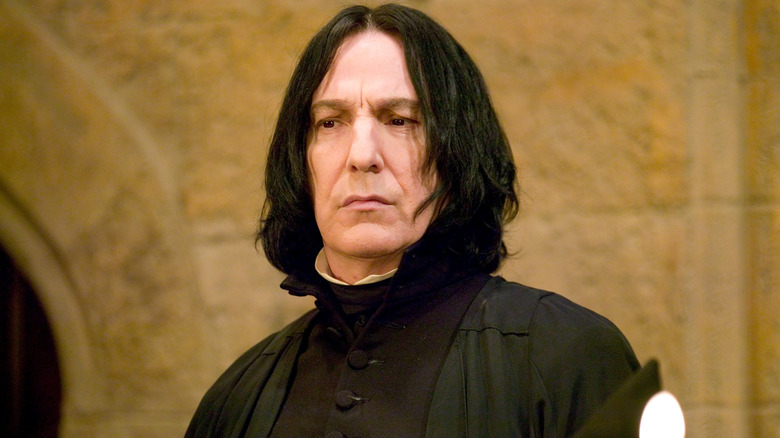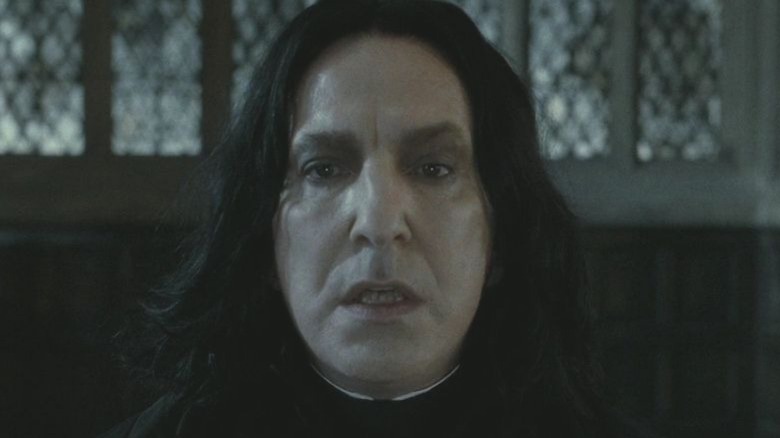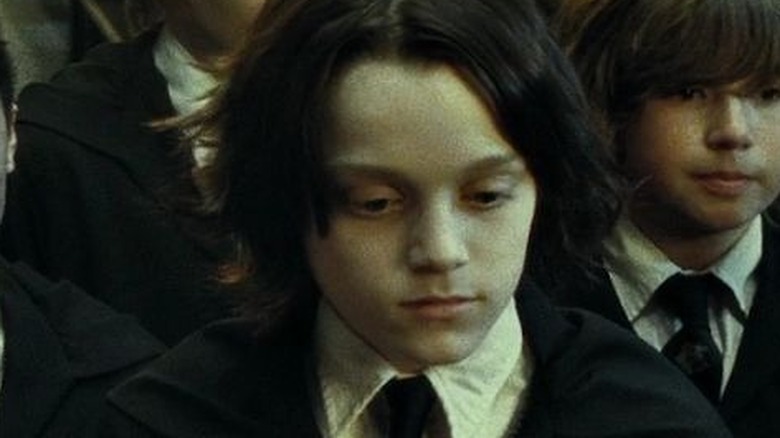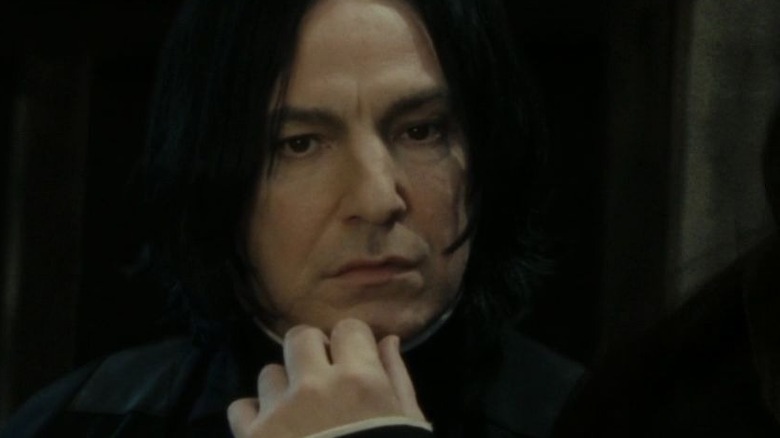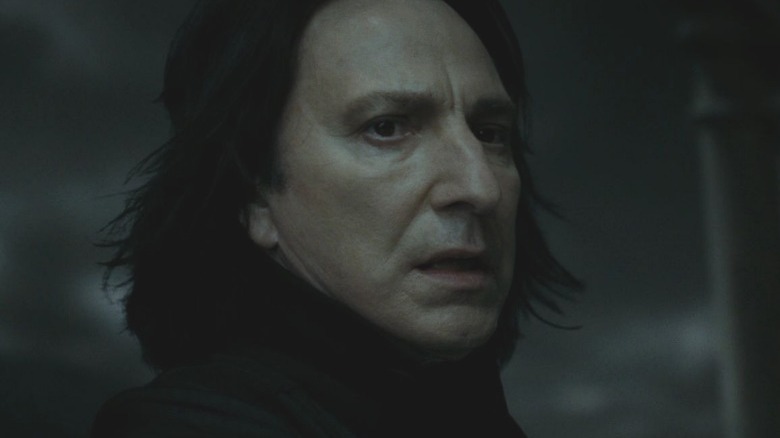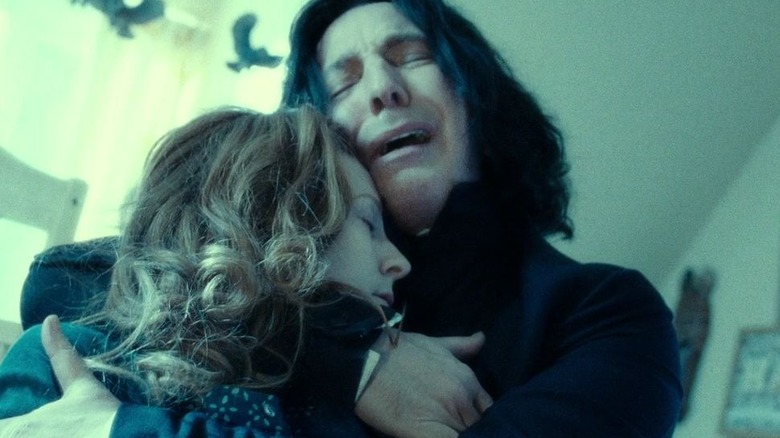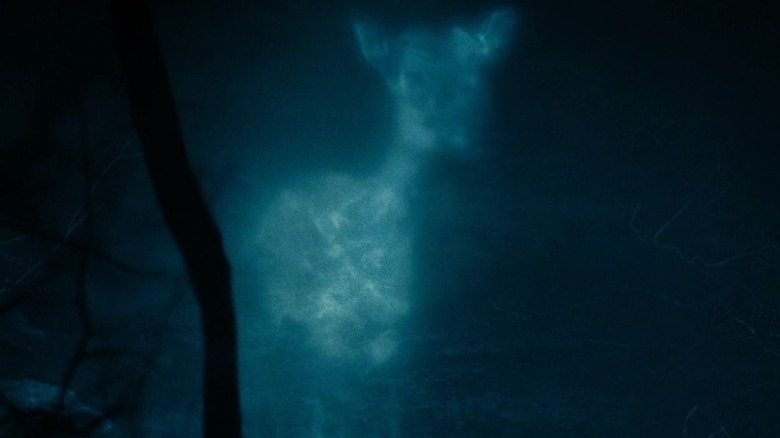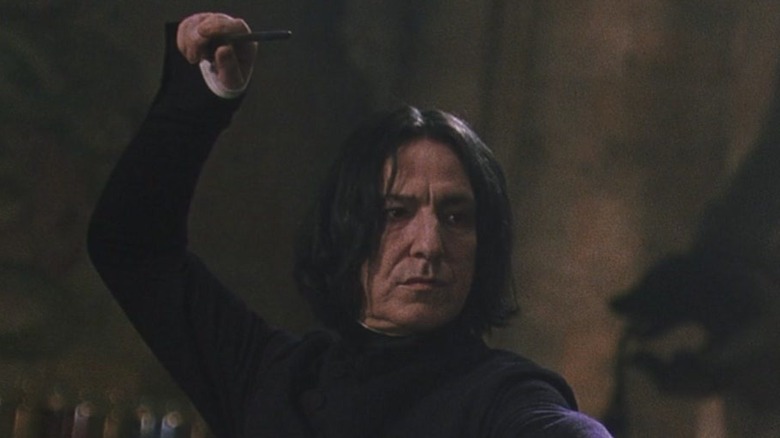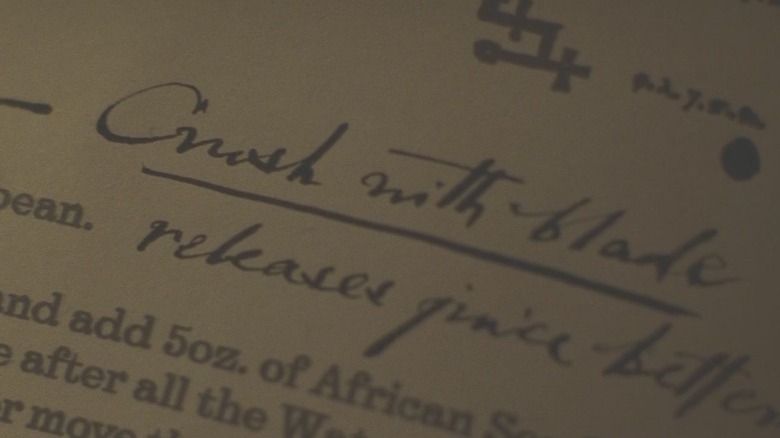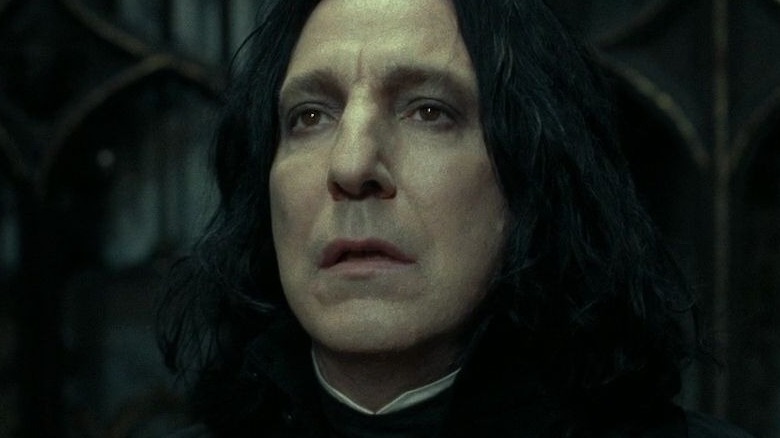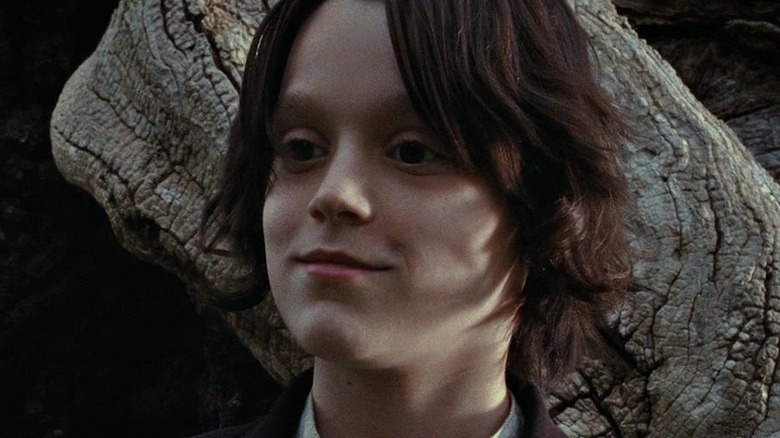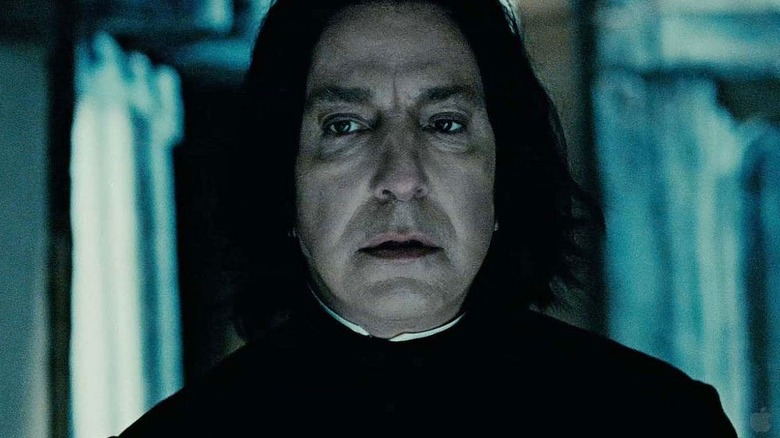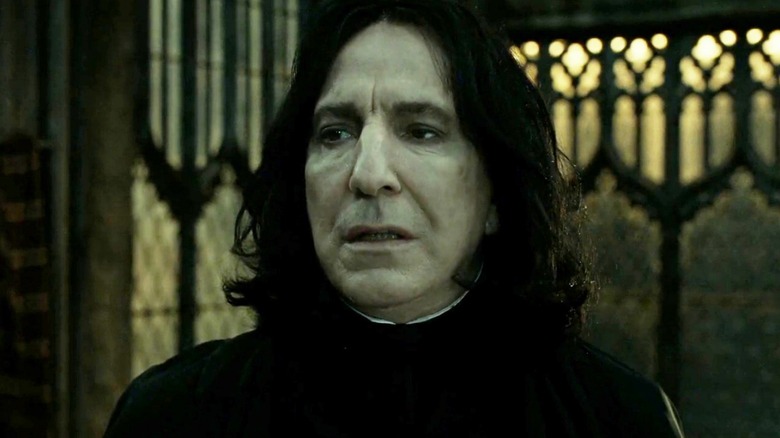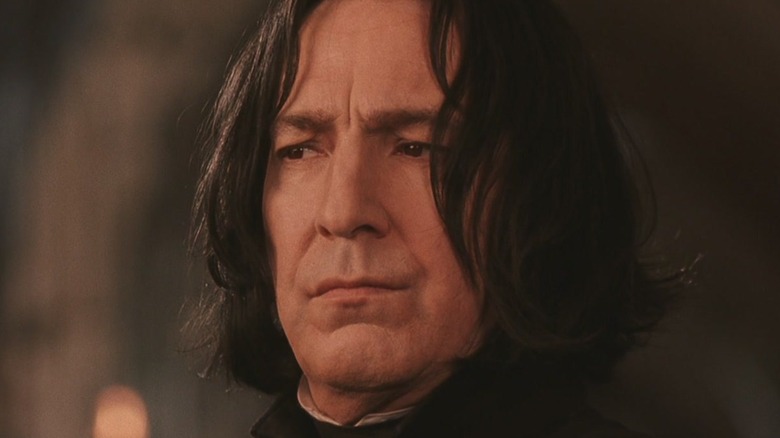The Spellbinding History Of Severus Snape From Harry Potter
There are many iconic professors in the "Harry Potter" franchise. From Gilderoy Lockhart, the Defense Against the Dark Arts professor who didn't seem very knowledgeable on the topic, to Horace Slughorn, a Potions professor who was more concerned with the connections he could make, chances are that even the most casual of fans can name a professor or two. One of them is even the worst villain in the franchise. But Severus Snape, a Potions professor who later became the headmaster of Hogwarts, is easily the most recognizable, from GIFs used across social media to the presence he had in the films.
Snape is seen as both an enemy and a hero. Throughout the series, he went out of his way to be rude and mean to Harry and other students, but in the end, it's revealed he did everything out of love. He degrades Harry on his first day of Potions in "Harry Potter and the Sorcerer's Stone," teaches students to duel in "Harry Potter and the Chamber of Secrets," and makes sure everyone knows Slytherin students are his favorite. Part of the appeal of the character is the actor who plays him in the movies: Alan Rickman perfectly encapsulated Snape, even though he almost turned down the role.
There is much more to the character than just a mean professor, including the reason why he turned away from the Dark Arts. Grab your wand to light the way as we share the spellbinding history of Severus Snape.
He is actually a half-blood
Like some other Death Eaters, and even Voldemort himself, Severus Snape is a half-blood wizard. His magical blood comes from his mother, Eileen Prince, whose identity is revealed in "Harry Potter and the Half-Blood Prince." When Hermione Granger figures out who Eileen is, we learn quite a bit about the Potions Master's mother. She was captain of the Hogwarts Gobstones Team and was also a Slytherin, based on a young Snape's memories, as shown in "Harry Potter and the Deathly Hallows."
Eileen marries a Muggle named Tobias Snape, which is announced in the Daily Prophet when it happens. As a family, the three of them live in Cokeworth, England. The town originally appears in the series when the Dursleys try to flee the Hogwarts letters in "Harry Potter and the Sorcerer's Stone." While living there, Snape meets Lily Evans, the woman that would become Harry's mother and the love of Snape's life.
Like other Slytherins, his family seems to believe that Muggle-born witches and wizards are lesser, which is evidenced by his hesitation before telling Lily it's okay to be Muggle-born in his memories. He also regularly uses the derogatory term for Muggle-borns, even using it against his friend.
He didn't have the best home life
With a Muggle father and magical mother, Snape's life ended up a bit different than most of his peers or colleagues. When he passes his memories to Harry as he's dying in "Harry Potter and the Deathly Hallows," the teen watches as Snape tells Lily that his parents are still arguing at home. His statement is in response to the girl asking him how everything is going at his house. "A little crease appeared between his eyes," Harry notes as he watches the memory. "Doesn't your dad like magic?" Lily asks her friend. He comments that his father doesn't really like anything.
Hogwarts should have been his escape from a difficult home life. Snape changes into his school robes almost as soon as he gets on the Hogwarts Express during his first year, ready to start a new chapter of his life. But he soon meets the group of boys that would bully him throughout his education on that first trip to school (via "Harry Potter and the Deathly Hallows"). What ensues is a multi-year battle between Snape and the boys that results in the main bully, James Potter, marrying Lily. Instead of escaping the issues of his home life, a new set of problems and people awaits him at school.
He's the one who tells Voldemort the prophecy
Sybill Trelawney, the Divination professor at Hogwarts, is the Seer who is graced with revealing the prophecy that predicts the demise of Voldemort. While interviewing for her job with Albus Dumbledore in the Hog's Head, the pub owned by his brother Aberforth, the Seer begins reciting a prophecy before his eyes. However, Snape is listening through the door.
In "Harry Potter and the Order of the Phoenix," Dumbledore notes that "the eavesdropper was detected only a short way into the prophecy and thrown from the building," which means Snape only heard a small portion of what the prophecy involves. As he runs to tell Voldemort what he heard, which is that someone who had defeated him three times would birth a son at the end of July that could take down Voldemort, he doesn't hear that in attempting to take the child's life, the Dark Lord could transfer some or all of his power to the baby, resulting in him causing his own downfall.
Trelawney believes Snape was trying to "pick up tips" for interviewing, as he was also in the market for a job at that time, which he does obtain shortly afterward (via "Harry Potter and the Half-Blood Prince").
How he became the Potions Master
After telling Voldemort what he'd heard, Snape's master makes a choice. There are two boys set to be born at the end of July: Harry Potter and Neville Longbottom. Voldemort plans to attack the Potters, believing the prophecy to be referring to them and their son. This is devastating to Snape, as it means Lily will perish.
In a selfish maneuver, he asks for Lily's life to be spared. While Voldemort says he won't kill her, and he will give her the choice to step aside as he moves toward Harry, Snape knows better. He visits Dumbledore, begging for help. The headmaster assumes Snape is there with a message from Voldemort, but he is actually there to ask a favor. He wants Dumbledore to hide the Potters (via "Harry Potter and the Deathly Hallows").
In exchange, he agrees to become a professor at Hogwarts, a member of the Order of the Phoenix, and a spy for Dumbledore. This exchange gives him the cover he needs for his first master, a safe home, and a place to easily communicate with Dumbledore without raising suspicion that he may have changed allegiances.
He's willing to let Harry die to save Lily
During his conversation with Dumbledore, Snape is only concerned about Lily surviving Voldemort's attack. The headmaster knows the wizard's intentions (via "Harry Potter and the Deathly Hallows"). "You do not care, then, about the deaths of her husband and child," he asks Snape. "They can die, as long as you have what you want?" At this point in his life, Snape is not the confident individual that fans come to know him as. He is described as "shrinking" at Dumbledore's words, something that the professor teaching the Golden Trio would never do.
When Peter Pettigrew gives away the location of the Potters, Lily and James are killed. As Snape meets with Dumbledore after that tragic night, his words are about Lily and no one else. "I thought ... you were going ... to keep her ... safe," he says. The headmaster reminds him that, as Snape had, the Potters put their trust in the wrong individual.
At that moment, Dumbledore tells the new Potions professor that he knows what he has to do. He can't let the love of his life die in vain; he needs to protect Harry from Voldemort's inevitable return. Snape agrees but insists that no one ever knows. Over the course of Harry's time at Hogwarts, Snape saves him from a spell caused by Professor Quirinus Quirrell in "Harry Potter and the Sorcerer's Stone" and even teaches him Occlumency at Dumbledore's request in "Harry Potter and the Order of the Phoenix."
The meaning of his Patronus
The Patronus Charm has come in handy throughout the series, useful for everything from sending important messages to people to scaring off Dementors. A wizard's Patronus says something about them, whether that's a character trait they hold dear or someone they love. Sometimes the shape their Patronus takes can change, but it is usually due to love or a significant change in character (via Wizarding World). For example, Nymphadora Tonks' Patronus changes from a jack rabbit to a wolf after she falls n love with Remus Lupin.
Snape's Patronus has never had to change. His was always a doe, just like Lily's was. This fact is revealed as Harry watches Snape's memories in "Harry Potter and the Deathly Hallows." As Snape and Dumbledore argue about whether Harry has to die to defeat Voldemort, the professor complains that he has been raising Lily's son this whole time "like a pig for slaughter." Dumbledore asks if he has taken a liking to Harry despite all the negative comments over the years, and Snape's response is to cast the Patronus Charm. The headmaster understands what the doe means, simply asking if he has really continued to love Lily all those years. His answer of "always" gives fans everything they need to know.
Snape invents his own spells
While many know Severus Snape for his potions work, especially considering he taught the course at Hogwarts, he also dabbles in spellwork. In "Harry Potter and the Half-Blood Prince," Harry is borrowing a copy of "Advanced Potion-Making" while he waits for his to arrive. The change in professor means he actually has the grade needed to continue onto N.E.W.T. level Potions, but he doesn't know that before arriving at school.
It turns out that the book he borrows belonged to Snape as a student. Throughout the margins are scribbled incantations, and even though Harry doesn't know what they do, he tries them out anyway. The tamest of the inventions is Muffliato, which makes sure no one around you can hear a conversation if you don't want them to. Others include one that can stick the victim's tongue to the roof of their mouth or another that makes their toenails grow really fast.
The last two are what readers see used more often. Levicorpus can be used to dangle someone upside down by their ankle. Snape even creates a counterspell for it (Liberacorpus). The most concerning of the spells is Sectumsempra, which Harry uses on Draco Malfoy in a bathroom. It causes deep cuts to appear on the victim's body. Snape runs into the two in the bathroom and is able to heal the wounds before Draco is killed, but it is at this moment that Snape knows that Harry has his old textbook.
He also improves existing potion recipes
Snape isn't only leaving new spell incantations in the margins of his textbook; he's also writing detailed notes about how to brew the potions already in it. During his first Potions class of the year, Harry borrows a copy of the textbook from the classroom since he doesn't have his own. The students are tasked with making the Draught of Living Death, a complex potion that few can brew correctly on the first try (via "Harry Potter and the Half-Blood Prince").
As Harry starts his brew, he notices that whoever had the book before him scribbled all over the margins. He is annoyed but soon finds the words can help him. He follows the notes and has more success than Hermione, who is arguably the best potion maker of the trio. While she struggles, Harry flourishes and wins the small vial of Felix Felicis, the lucky potion, as a prize for having the best attempt. He offers the notes to Hermione while they are working, but she rejects them and continues to do so when Harry tells her why he's doing so well in the class.
Snape's corrections to the recipes, like crushing sopophorous beans instead of cutting them, clearly haven't been submitted anywhere if Hermione's new copy of the book doesn't reflect them. Like his spells, it looks like the Potions Master was keeping them to himself.
How he helps Harry on his hunt for Horcruxes
Like other parts of Snape's backstory, the aid he gives Harry in "Harry Potter and the Deathly Hallows" is revealed as Harry walks through the professor's memories. After Dumbledore's death in "Harry Potter and the Half-Blood Prince," Voldemort takes over Hogwarts and appoints Snape the new headmaster. This works in Snape and Dumbledore's favor because it means he can speak to the former headmaster's portrait, allowing them to continue their plotting from behind the scenes.
Dumbledore arranges for Snape to get the Sword of Gryffindor, one of the few items that can destroy a Horcrux, to Harry and his friends on their travels. Dumbledore is adamant that they can not know it is the professor giving it to them. Snape reassures him he has a plan that will make sure Harry doesn't see him, even though he doesn't know why the teen needs the sword in the first place.
While camping in the Forest of Dean, Harry sees Snape's silver doe Patronus, though he didn't know who it belongs to. The doe leads him to a frozen lake, where the Sword of Gryffindor is waiting underneath the surface. Harry dives into the water to get it and is saved by Ron when the Salazar Slytherin locket Horcrux begins to strangle Harry. This marks Ron's return to the group. Neither of them sees Snape leave the sword or cast his Patronus.
The author's inspiration for the character
While the inspiration for many names in the series, most notably those that relate to the stars or constellations, are well-known, fans may not know the inspiration for both the name and personality of Severus Snape. His name, though it just appeared in her head and she hadn't made the connection initially, came from the name of a street that J.K. Rowling used to walk by all the time.
On Twitter in 2020, she posted a photo of the street sign bearing the name "Severus" and explained that she used to walk by it every day on her way to work. She noted that she only realized this is where the name came from after some of the books were published. She confirmed the inspiration for the last name in an interview with eToys from 2000 (via Accio-Quote), saying, "'Snape' is the name of a place in England." It is a village name used throughout the country.
An article from The Herald (also via Accio-Quote) revealed that Rowling based Snape's personality on "a compendium of all the bullying teachers she ever encountered." It turns out his personality and name, though not intentionally put together, do make a great pair. "Severus" can be translated from Latin to mean "stern," which certainly describes the character well. "Snape" is based on an old Norse term, "sneypa," that is thought to mean "disgrace" or "shame" (via Wizarding World).
The author apologized for killing the character
It's become a tradition for J.K. Rowling to apologize for killing a character on May 2. This is the day when the Battle of Hogwarts, the final battle between Lord Voldemort and Harry, takes place. Starting in 2015, Rowling would tweet the name of a single character that she was sorry for killing after expressing that she didn't like killing certain characters the year before (via Cinemablend). The first character she apologized for was Fred Weasley, one of the Weasley twins, who died during the battle. In the years that followed, she also apologized for Dobby the house-elf and Remus Lupin.
In 2017, she took to Twitter to once again give an apology — this time, for killing Severus Snape. Her tweet also recognized how controversial the fan base may find this admission, commenting that she was going to "run for cover." Fans in the replies certainly were divided, with someone asking her to apologize for Nymphadora Tonks and Sirius Black instead, while author Hank Green simply said, "I don't need this today!" It is suspected she indirectly apologized for Black's death in 2019 when she changed her Twitter cover photo to a picture of a sky full of stars around May 2. She did not make an official apology tweet that year.
Alan Rickman knew the end of Snape's story before everyone else
The "Harry Potter" movies began filming before J.K. Rowling had finished writing the books, but she did have an idea of where everything, and everyone, was headed. To give him some more insight, Rickman asked the author about Snape's character arc. In journal entries revealed by The Guardian, he was given the information he asked for by Rowling in 2000. On October 6, he wrote that he called her at home, telling her he needed to know the "things that only Snape and you know." She agreed and told him to call back the next day. His October 7 entry noted, "She nervously lets me in on a few glimpses of Snape's background."
Later, Rickman wrote that she told him his character loved Lily. He mentioned this in an entry from July 27, 2007, after he finished reading "Harry Potter and the Deathly Hallows," saying that the information gave him "a cliff edge to hang on to." Rowling admitted on Twitter in 2016 that she told Rickman what the meaning was behind Snape's iconic line, "Always," as part of their discussions about the character. In a 2011 interview with the Los Angeles Times, the actor commented, "I knew with Snape I was working as a double agent, as it turns out, and a very good one at that."
Rickman shared his thoughts on Snape's death scene
Alan Rickman's journal entries reveal some of his innermost thoughts about his life and the projects he participated in. In addition to giving a timeline of when he asked J.K. Rowling to tell him more about Snape, he made notes about how he felt when viewing the movies at premieres and throughout filming.
One of the most intriguing entries is his description of filming his character's death, written in November 2009 (via The Guardian). "[The scene is] the absolute example of what can happen when a couple of actors pick up a scene off the page and work with the story, the space and each other," the actor wrote. "Stuart Craig's boathouse [set] gave it something ironic and everlasting."
Rickman also commented on how putting on the character's costume made him change as a person. In an entry from 2006, he noted that he felt himself become closed off the minute the costume went on. "The character narrows me down, tightens me up. Not good qualities on a film set," he reflected. "I have never been less communicative with a crew. Fortunately, Dan [Radcliffe] fills that role with ease and charm. And youth."
